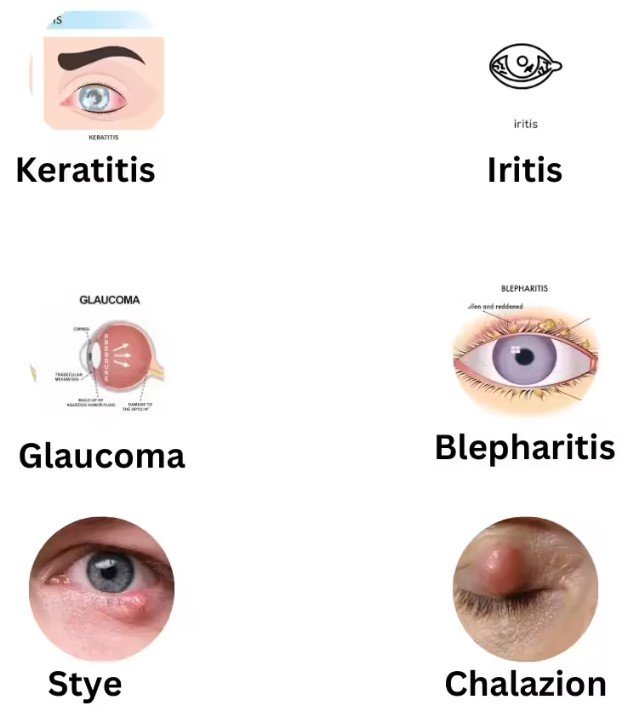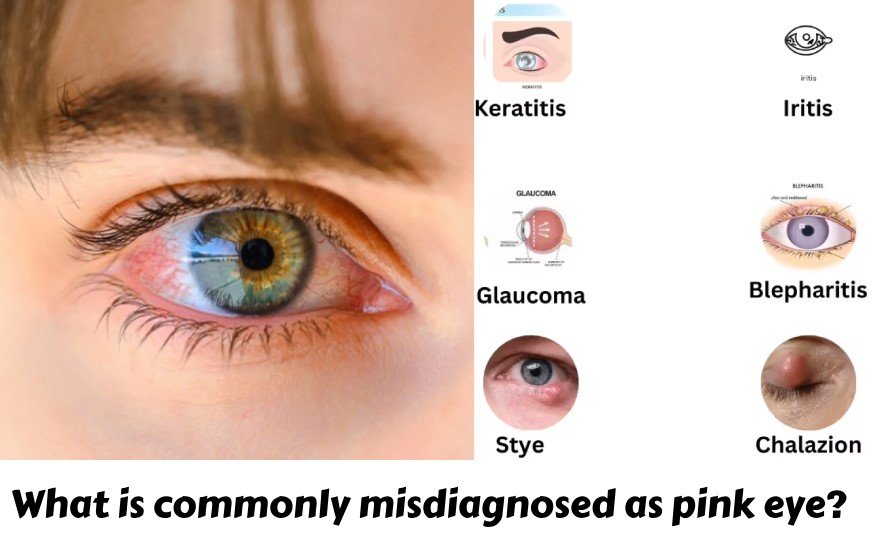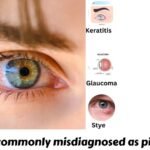Commonly misdiagnosed as pink eye: Conjunctivitis, commonly known as pink eye, manifests through the inflammation of the conjunctiva, often resulting from infections or allergic reactions. The symptoms vary based on its cause – bacterial, viral, or allergic – including:
- Eye redness
- A gritty sensation
- Itching
- A burning feeling
- Swollen eyelids
- Discharge or increased tear production
- Blurred vision
- Light sensitivity
- Mild discomfort
Table of Contents
What is commonly misdiagnosed as Pink eye – Conjunctivitis?

Yet, various other conditions exhibit similar symptoms, leading to frequent misdiagnoses. Below, we delve into these conditions, highlighting their differences from pink eye.
Type of Conjunctivitis (Pink Eyes)

Alternative Conditions Mistaken for Pink Eye
Eye redness, irritation, and unusual discharge are symptoms commonly associated with pink eye. Nonetheless, these indicators can also suggest several other eye conditions.
Visiting a healthcare professional for accurate diagnosis is always advised if you experience any discomfort or visual disturbances.
1. Stye (Hordeolum)
Often forming along the lash line or inside the eyelid, styes are characterized by a painful, pimple-like red bump, accompanied by eyelid swelling, distinguishing them from pink eye.
2. Eyelid Inflammation (Blepharitis)
Blepharitis, an inflammation of the eyelid, differs from pink eye due to eyelid swelling and symptoms of dryness, leading to the production of foamy tears.
3. Corneal Inflammation (Keratitis)
Sharing many symptoms with pink eye, keratitis, or inflammation of the cornea, is usually more painful, indicating a distinct condition.
4. Iritis and Uveitis
Uveitis, an inflammation within the eye caused by autoimmune diseases, infections, or certain cancers, can lead to floaters for inner eye inflammation and heightened light sensitivity for anterior inflammation, unlike pink eye.
5. Glaucoma
This degenerative eye condition results from optic nerve damage. Unlike pink eye, glaucoma lacks redness or discharge symptoms, with early stages often symptom-free.
6. Allergies
Allergies can cause eye redness similar to pink eye but are uniquely identified by persistent itchiness and, unlike pink eye, don’t typically produce discharge.
7. Dry Eye Syndrome
A chronic lack of tears leads to dry eye syndrome, presenting symptoms akin to pink eye but distinguished by a stinging sensation.
8. Episcleritis
Inflammation of the episclera can cause redness and discomfort without the vision issues or discharge commonly seen in pink eye cases.
9. Corneal Abrasion
Resulting from scratches to the cornea, this injury causes pain and visual disturbances, differing from pink eye symptoms.
10. Chalazion
This eyelid bump can lead to redness and swelling, occasionally causing extensive eyelid inflammation.
11. Scleritis
Characterized by inflammation of the sclera, scleritis shares pink eye symptoms except for thick discharge, with pain possibly extending to the jaw and face.
Treatment for pink eye and other conditions that are commonly mistaken for it
| Condition | Treatment Options |
|---|---|
| Pink Eye | Cool compresses, Artificial tears, Antibiotic eye drops (for bacterial conjunctivitis only), Allergy eye drops (for allergic conjunctivitis) |
| Stye | Antibiotics, Warm compresses, Surgery to drain the bump |
| Blepharitis | Artificial tears, Antibiotics, Steroid eye drops, Warm compresses |
| Keratitis | Artificial tears, Oral antibiotics or antibiotic eye drops (infectious keratitis only), Nonsteroidal anti-inflammatory drugs (NSAIDs) |
| Iritis and Uveitis | Steroid eye drops, Oral or injectable steroids, Steroid implants in your eye |
| Glaucoma | Prescription eye drops, Laser treatments, Surgery to promote fluid drainage out of your eye |
| Allergies | Antihistamine eye drops, Oral antihistamines, Steroid nasal sprays, Allergy shots (immunotherapy) |
| Dry Eye | Artificial tears, Immunosuppressive eye drops, Tear duct plugs, Surgery |
| Episcleritis | Artificial tears, Steroid drops or ointment, Oral or topical NSAIDs |
| Corneal Abrasion or other injury | Over-the-counter (OTC) pain medications, Artificial tears, Antibiotic drops to treat or prevent infections, Pressure eye patch or bandage contact lens |
| Chalazion | Warm compresses, Steroid shots, Surgery to help drain the bump |
| Scleritis | OTC pain medications, Steroid eye drops, Oral steroids or injections, Immunosuppressive medications, Biologics |
This table synthesizes the treatment options for pink eye and related conditions, aiming to provide clear and concise information for better understanding and readability.
Seeking Medical Advice
It’s crucial to consult a doctor if symptoms persist, indicate an infection, follow an injury, or are linked to a chronic condition, ensuring appropriate treatment.
10 Best Vegan Multivitamin for Women Pros, Cons and Benefits
Conclusion
While pink eye is known for its redness, blurriness, and watery eyes, similar symptoms can indicate a range of other conditions. Accurate diagnosis is key to receiving effective treatment, emphasizing the importance of professional medical consultation.
FAQ’s
What makes keratitis different from pink eye?
Keratitis is the inflammation of the cornea and shares many symptoms with pink eye, including redness, pain, and blurred vision. However, keratitis is often more painful than conjunctivitis and can include severe pain when looking at bright lights, which is not common with pink eye.
When should I seek medical attention for eye symptoms?
You should see a doctor if your eye symptoms persist for more than a couple of days, you suspect an eye infection, have experienced an eye injury, or if you have an underlying chronic medical condition like an autoimmune disease. Proper diagnosis and treatment are essential for eye health.
Pink eye, or conjunctivitis, is often characterized by redness, itchiness, and discharge among other symptoms. However, these symptoms can also be indicative of styes, blepharitis, keratitis, iritis, uveitis, glaucoma, allergies, dry eye, episcleritis, corneal abrasions, chalazions, and scleritis. It’s important to consult a healthcare professional for an accurate diagnosis as each condition has its unique treatment approach.
Yes, a stye, which typically appears as a painful red bump near the eyelashes or on the eyelid, can cause redness and swelling similar to pink eye. However, styes are often more localized and do not usually involve the same level of discharge as conjunctivitis.
While both pink eye and dry eye syndrome can cause redness and a gritty feeling, dry eye syndrome is primarily characterized by a stinging sensation and is a chronic condition. Pink eye tends to develop suddenly and may include symptoms like discharge and increased tear production.





